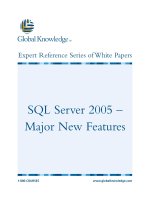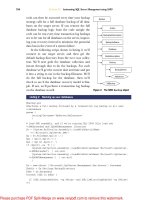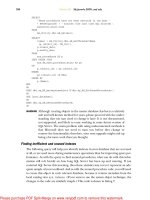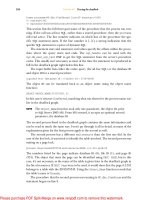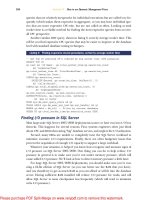Tài liệu SQL Server 2012 with PowerShell V3 Cookbook docx
Bạn đang xem bản rút gọn của tài liệu. Xem và tải ngay bản đầy đủ của tài liệu tại đây (18.61 MB, 634 trang )
SQL Server 2012
with PowerShell V3
Cookbook
Increase your productivity as a DBA, developer, or IT Pro, by using PowerShell with SQL Server
to simplify database management and automate repetitive, mundane tasks.
Donabel Santos
PUBLISHING
professional expertise distilled
BIRMINGHAM - MUMBAI
SQL Server 2012 with PowerShell V3
Cookbook
Copyright © 2012 Packt Publishing
All rights reserved. No part of this book may be reproduced, stored in a retrieval system, or
transmitted in any form or by any means, without the prior written permission of the publisher,
except in the case of brief quotations embedded in critical articles or reviews.
Every effort has been made in the preparation of this book to ensure the accuracy of the
information presented. However, the information contained in this book is sold without
warranty, either express or implied. Neither the author, nor Packt Publishing, and its dealers
and distributors will be held liable for any damages caused or alleged to be caused directly or
indirectly by this book.
Packt Publishing has endeavored to provide trademark information about all of the companies
and products mentioned in this book by the appropriate use of capitals. However, Packt
Publishing cannot guarantee the accuracy of this information.
First published: October 2012
Production Reference: 1151012
Published by Packt Publishing Ltd.
Livery Place
35 Livery Street
Birmingham B3 2PB, UK.
ISBN 978-1-84968-646-4
www.packtpub.com
Cover Image by Artie Ng ()
Credits
Author
Donabel Santos
Reviewers
Edwin Sarmiento
Laerte Poltronieri Junior
Acquisition Editor
Rukhsana Khambatta
Lead Technical Editor
Azharuddin Sheikh
Technical Editors
Charmaine Pereira
Sharvari Baet
Jalasha D'costa
Copy Editors
Alda Paiva
Brandt D'Mello
Insiya Morbiwala
Aditya Nair
Project Coordinator
Yashodhan Dere
Proofreader
Chris Smith
Indexer
Tejal R. Soni
Production Coordinator
Manu Joseph
Cover Work
Manu Joseph
About the Author
Donabel Santos is a SQL Server MVP and is the senior SQL Server Developer/DBA/
Trainer at QueryWorks Solutions, a consulting and training company in Vancouver, BC. She
has worked with SQL Server since version 2000 in numerous development, tuning, reporting,
and integration projects with ERPs, CRMs, SharePoint, and other custom applications. She
holds MCITP certications for SQL Server 2005/2008, and an MCTS for SharePoint. She is a
Microsoft Certied Trainer (MCT), and is also the lead instructor for SQL Server Administration,
Development, and SSIS courses at British Columbia Institute of Technology (BCIT).
Donabel is a proud member of PASS (Professional Association of SQL Server), and a proud BCIT
alumna (CST diploma and degree). She blogs (
www.sqlmusings.com), tweets (@sqlbelle),
speaks and presents (SQLSaturday, VANPASS, Vancouver TechFest, and so on), trains (BCIT,
QueryWorks Solutions), and writes (Packt, Idera, SSWUG, and so on).
Acknowledgement
Writing a book would not be possible without the unwavering support of family, friends,
colleagues, mentors, acquaintances, and an awesome community. This is my rst book,
a dream come true, so please forgive me if I go overboard with my thanks.
To Eric, thank you… for nding me. Despite long days, sleepless nights, lengthy writing
marathons, one smile from you never fails to wipe away my tiredness. Thank you for always
supporting me, for believing in me, for helping me reach whichever dreams I dare to chase.
I look forward to our journey together—a lifelong of hopes, dreams, and happiness.
To Mama and Papa, I am the luckiest daughter to have you as my parents. Thank you for all
the sacrices you made for me and my brothers. Words are not enough to express how much
we love you, and how grateful we will always be.
To JR and RR—you will always be my baby brothers, and I am so proud to be your big sis. To
Lisa, my dear sis-in-law, thank you for being part of our family. The whole family adores you.
To Veronica, thanks for keeping up with the Santos' quirks. You're cool, girl! Now that the book
is done, we can all play more Kinect, Acquire, and Ticket to Ride.
To my in laws—Mom Lisa, Dad Richard, Ama, Aunt Rose, Catherine, David, and Jayden—thank
you for always making me feel welcome, for never making me feel I am different from your
family. And to my unborn niece Kristina, auntie will teach you and Jayden SQL Server… one of
these years.
To Edwin Sarmiento and Laerte Junior—my utmost and sincerest thanks for all the advice
and constructive feedback. I have the highest respect for both of you. It is very humbling to
work with both of you, and I learned so much from all the corrections and suggestions. Thank
you for bearing with me through the revisions, despite your respective hectic schedules and
numerous other commitments. I am very grateful.
To Elsie Au, thank you for introducing me to databases. I cannot imagine doing anything else.
Thank you for the friendship all these years. To Kevin Cudihee, thank you for all the support all
these years, for letting me do two things that I love the most—teaching and SQL Server. To Anne
Marie Johnston and Alan Marchant, thank you for giving me fun work with databases. To my
students, thank you for learning, sharing, and growing with me.
To BCIT—my second home. To me, BCIT was my place of refuge. When I was at a low point in
my life, feeling down and out, and without direction (and afraid of computers!), BCIT provided
me a place to learn, grow, and dream again. Now as an instructor, I hope I can help give back
to students what BCIT gave me when I was one.
To the SQL community, the SQL family, and the SQL Server MVPs—I am so proud to be part
of this group. There are so many smart SQL rockstars that I admire (Brent Ozar, Glenn Berry,
Kevin Kline, Brian Knight, Grant Fritchey, Jorge Sergarra, Jeremiah Peschka, Jen Stirrup, and
so many others I would love to mention and thank), who are way up there, yet who are always
ready to help and inspire anyone who asks. "Community" for this group is not just lip service.
It's the SQL way of life. I have learned so much from this community, and I would not be
anywhere near where I am today if not for the seless way this community shares and helps.
To the PowerShell community, thank you to the awesome authors, bloggers, and tweeps.
Your articles, blogs, and books have immensely helped folks like me to learn, understand,
and get excited about PowerShell.To Microsoft and the SQL Server and PowerShell respective
Product Teams —thanks for creating these two amazing products. It doubles the fun for SQL
geeks like me!
To the Packt team—Dhwani Dewater, Yashodhan Dere, Azharuddin Sheikh, Charmaine Pereira,
Sharvari Baet and the rest of the editors and technical reviewers—thank you for giving me the
chance to write this book and helping me as the book writing progressed. It is one of the most
humbling, but also one of the most rewarding experiences.
To numerous friends (Shereen Qumsieh, Matthew Carriere, Grace Dimaculangan, Ben Peach,
Yaroslav Pentsarskyy, Joe Xing, Min Zhu, Mary Mootatamby, Blake Wiggs, and many others), to
all of my mentors and students, acquaintances via twitter (such as @pinaldave, @dsfnet,
@StangSCT, @retracement, @NikoNeugebauer, @TimCost), and so many others who
have helped, inspired, and encouraged me along the way—thank you.
And most importantly, thank you Lord, for all the miracles and blessings in my life.
About the Reviewers
Edwin Sarmiento is a Microsoft SQL Server MVP from Ottawa, Canada specializing in
high availability, disaster recovery, and system infrastructures running on the Microsoft
server technology stack. He is very passionate about technology but has interests in music,
professional and organizational development, leadership, and management matters when
not working with databases. He lives up to his primary mission statement—To help people
and organizations grow and develop their full potential as God has planned for them.
He wants the whole world to know that the FILIPINO is a world-class citizen and brings
Jesus Christ to the world.
Laerte Poltronieri Junior started in the IT world early, at the age of 12. When 16, he was
developing software using Clipper Summer 85 and he used almost all versions. Then in 1998
he was introduced to SQL Server 6.5; since then it was love at rst sight and marriage. In 2008,
he met PowerShell and as he is an acionado for automated, smart, and exible solutions in
SQL Server, from this marriage was born a son. And today they are a happy family.
Currently, he is writing a book for Manning Publications.
First of all, I would like to thank God. I have not always been a guy next
to him, but I'm learning to give back all the love and affection that he has
given me.
My family—my father, an unforgettable super-hero, my beloved mother
and grandma, and my dear sister and nephews.
Also, a special thanks to some exceptional professionals and friends who
are teaching and mentoring me from the beginning: Buck Woody, Chad
Miller, Shay Levy, and Ravikanth Chaganti.
And last but not the least, all the #sqlfamily , #powershell and Simple-Talk
friends, you guys simply rock. I owe you all the good things that happened
and are happening to me.
www.PacktPub.com
Support les, eBooks, discount offers and more
You might want to visit www.PacktPub.com for support les and downloads related to
your book.
Did you know that Packt offers eBook versions of every book published, with PDF and ePub
les available? You can upgrade to the eBook version at
www.PacktPub.com and as a print
book customer, you are entitled to a discount on the eBook copy. Get in touch with us at
for more details.
At
www.PacktPub.com, you can also read a collection of free technical articles, sign up
for a range of free newsletters and receive exclusive discounts and offers on Packt books
and eBooks.
TM
Do you need instant solutions to your IT questions? PacktLib is Packt's online digital book
library. Here, you can access, read and search across Packt's entire library of books.
Why Subscribe?
f Fully searchable across every book published by Packt
f Copy and paste, print and bookmark content
f On demand and accessible via web browser
Free Access for Packt account holders
If you have an account with Packt at www.PacktPub.com, you can use this to access
PacktLib today and view nine entirely free books. Simply use your login credentials for
immediate access.
Instant Updates on New Packt Books
Get notied! Find out when new books are published by following @PacktEnterprise on
Twitter, or the Packt Enterprise Facebook page.
Table of Contents
Preface 1
Chapter 1: Getting Started with SQL Server and PowerShell 7
Introduction 7
Before you start: Working with SQL Server and PowerShell 10
Working with the sample code 12
Exploring the SQL Server PowerShell hierarchy 14
Installing SMO 18
Loading SMO assemblies 20
Discovering SQL-related cmdlets and modules 22
Creating a SQL Server instance object 29
Exploring SMO server objects 32
Chapter 2: SQL Server and PowerShell Basic Tasks 35
Introduction 36
Listing SQL Server instances 39
Discovering SQL Server services 43
Starting/stopping SQL Server services 45
Listing SQL Server conguration settings 51
Changing SQL Server instance congurations 55
Searching for database objects 60
Creating a database 67
Altering database properties 68
Dropping a database 72
Changing a database owner 73
Creating a table 75
Creating a view 81
Creating a stored procedure 85
Creating a trigger 90
Creating an index 95
ii
Table of Contents
Executing a query / SQL script 99
Performing bulk export using Invoke-Sqlcmd 100
Performing bulk export using bcp 102
Performing bulk import using BULK INSERT 105
Performing bulk import using bcp 110
Chapter 3: Basic Administration 115
Introduction 116
Creating a SQL Server instance inventory 116
Creating a SQL Server database inventory 120
Listing installed hotxes and service packs 124
Listing running/blocking processes 128
Killing a blocking process 131
Checking disk space usage 133
Setting up WMI Server event alerts 136
Detaching a database 143
Attaching a database 145
Copying a database 149
Executing a SQL query to multiple servers 152
Creating a legroup 153
Adding secondary data les to a legroup 156
Moving an index to a different legroup 158
Checking index fragmentation 162
Reorganizing/rebuilding an index 164
Running DBCC commands 167
Setting up Database Mail 168
Listing SQL Server jobs 178
Adding a SQL Server operator 181
Creating a SQL Server job 183
Adding a SQL Server event alert 187
Running a SQL Server job 190
Scheduling a SQL Server job 192
Chapter 4: Security 203
Introduction 203
Listing SQL Server service accounts 204
Changing SQL Server service account 206
Listing authentication modes 210
Changing authentication mode 211
Listing SQL Server log errors 215
Listing failed login attempts 220
Listing logins, users, and database mappings 222
iii
Table of Contents
Listing login/user roles and permissions 225
Creating a login 227
Assigning permissions and roles to a login 229
Creating a database user 232
Assigning permissions to a database user 234
Creating a database role 237
Fixing orphaned users 241
Creating a credential 244
Creating a proxy 246
Chapter 5: Advanced Administration 251
Introduction 252
Listing facets and facet properties 252
Listing policies 254
Exporting a policy 257
Importing a policy 261
Creating a condition 264
Creating a policy 268
Evaluating a policy 272
Enabling/disabling change tracking 275
Running and saving a proler trace event 276
Extracting the contents of a trace le 284
Creating a database master key 289
Creating a certicate 291
Creating symmetric and asymmetric keys 293
Setting up Transparent Data Encryption (TDE) 299
Chapter 6: Backup and Restore 305
Introduction 305
Changing database recovery model 306
Listing backup history 309
Creating a backup device 310
Listing backup header and le list information 312
Creating a full backup 316
Creating a backup on mirrored media sets 321
Creating a differential backup 324
Creating a transaction log backup 327
Creating a legroup backup 329
Restoring a database to a point in time 332
Performing an online piecemeal restore 342
iv
Table of Contents
Chapter 7: SQL Server Development 351
Introduction 351
Inserting XML into SQL Server 352
Extracting XML from SQL Server 355
Creating an RSS feed from SQL Server content 358
Applying XSL to an RSS feed 363
Storing binary data into SQL Server 366
Extracting binary data from SQL Server 370
Creating a new assembly 374
Listing user-dened assemblies 378
Extracting user-dened assemblies 379
Chapter 8: Business Intelligence 385
Introduction 386
Listing items in your SSRS Report Server 386
Listing SSRS report properties 388
Using ReportViewer to view your SSRS report 391
Downloading an SSRS report in Excel and PDF 396
Creating an SSRS folder 400
Creating an SSRS data source 404
Changing an SSRS report's data source reference 409
Uploading an SSRS report to Report Manager 412
Downloading all SSRS report RDL les 416
Adding a user with a role to an SSRS report 421
Creating folders in an SSIS package store and MSDB 425
Deploying an SSIS package to the package store 428
Executing an SSIS package stored in the package store or File System 430
Downloading an SSIS package to a le 433
Creating an SSISDB catalog 435
Creating an SSISDB folder 439
Deploying an ISPAC le to SSISDB 441
Executing an SSIS package stored in SSISDB 444
Listing SSAS cmdlets 447
Listing SSAS instance properties 448
Backing up an SSAS database 450
Restoring an SSAS database 451
Processing an SSAS cube 452
Chapter 9: Helpful PowerShell Snippets 455
Introduction 456
Documenting PowerShell script for Get-Help 456
Getting a timestamp 459
v
Table of Contents
Getting additional error messages 461
Listing processes 462
Getting aliases 466
Exporting to CSV and XML 467
Using Invoke-Expression 468
Testing regular expressions 470
Managing folders 474
Manipulating les 476
Searching for les 478
Reading an event log 481
Sending e-mail 482
Embedding C# code 484
Creating an HTML report 486
Parsing XML 488
Extracting data from a web service 490
Using PowerShell Remoting 492
Appendix A: SQL Server and PowerShell CheatSheet 497
Learning PowerShell 497
PowerShell V2 versus V3 Where-Object syntax 498
Changing execution policy 498
Running a script 499
Common aliases 499
Displaying output 500
Special characters 500
Special variables 501
Common operators 502
Common date-time format strings 502
Comment based help 503
Here-string 504
Common regex characters and patterns 504
Arrays and hash tables 505
Arrays and loops 506
Logic 506
Functions 507
Common Cmdlets 508
Import SQLPS module 509
Add SQL Server Snapins 509
Add SQL Server Assemblies 509
Getting credentials 510
Running and blocking SQL Server processes 510
Read le into an array 510
vi
Table of Contents
SQL Server-Specic Cmdlets 510
Invoke-SqlCmd 512
Create SMO Server Object 512
Create SSRS Proxy Object 512
Create SSIS Object (SQL Server 2005/2008/2008R2) 513
Create an SSIS Object (SQL Server 2012) 513
Create SSAS Object 513
Appendix B: PowerShell Primer 515
Introduction 515
What is PowerShell, and why learn another language 515
Setting up the Environment 516
Running PowerShell scripts 517
Basics—points to remember 520
Scripting syntax 527
Converting script into functions 539
More about PowerShell 542
Appendix C: Resources 543
Resources 543
Appendix D: Creating a SQL Server VM 549
Introduction 549
Terminology 550
Downloading software 551
VM details and accounts 552
Creating an empty virtual machine 553
Installing Windows Server 2008 R2 as
Guest OS 556
Installing VMWare tools 567
Conguring a domain controller 569
Creating domain accounts 577
Installing SQL Server 2012 on a VM 580
Installing sample databases 598
Installing PowerShell V3 598
Index 601
Preface
PowerShell is Microsoft's new command-line shell and scripting language that promises to
simplify automation and integration across different Microsoft applications and components.
Database professionals can leverage PowerShell by utilizing its numerous built-in cmdlets,
or using any of the readily available .NET classes, to automate database tasks, simplify
integration, or just discover new ways to accomplish the job at hand.
SQL Server 2012 with PowerShell V3 Cookbook provides easy-to-follow, practical examples
for the busy database professional. Whether you're auditing your servers, or exporting data,
or deploying reports, there is a recipe that you can use right away!
You start off with basic topics to get you going with SQL Server and PowerShell scripts
and progress into more advanced topics to help you manage and administer your SQL
Server databases.
The rst few chapters demonstrate how to work with SQL Server settings and objects,
including exploring objects, creating databases, conguring server settings, and performing
inventories. The book then dives deeply into more administration topics such as backup and
restore, credentials, policies, and jobs.
Additional development and BI-specic topics are also explored, including deploying and
downloading assemblies, BLOB data, SSIS packages, and SSRS reports.
A short PowerShell primer is also provided as a supplement in the Appendix, which the
database professional can use as a refresher or occasional reference material. Packed with
more than 100 practical, ready-to-use scripts, SQL Server 2012 with PowerShell V3 Cookbook
will be your go-to reference in automating and managing SQL Server.
What this book covers
Chapter 1, Getting Started with SQL Server and PowerShell explains what PowerShell is, and
why you should consider learning PowerShell. It also introduces PowerShell V3 new features,
and explains what needs to be in place when working with SQL Server 2012 and PowerShell.
Preface
2
Chapter 2, SQL Server and PowerShell Basic Tasks demonstrates scripts and snippets
of code that accomplish some basic SQL Server tasks using PowerShell. We start with
simple tasks such as listing SQL Server instances, and creating objects such as tables,
indexes, stored procedures, and functions to get you comfortable while working with
SQL Server programmatically.
Chapter 3, Basic Administration tackles more administrative tasks that can be accomplished
using PowerShell, and provides recipes that can help automate a lot of repetitive tasks. Some
recipes deal with instance and database properties; others provide ways of checking disk space,
creating WMI alerts, setting up Database Mail, and creating and maintaining SQL Server Jobs.
Chapter 4, Security provides snippets that simplify security monitoring, including how to check
failed login attempts by parsing out event logs, or how to administer roles and permissions.
Chapter 5, Advanced Administration shows how PowerShell can help you leverage features
such as Policy Based Management (PBM) and encryption using PowerShell. This chapter also
explores working with SQL Server Proler trace les and events programmatically.
Chapter 6, Backup and Restore looks into different ways of backing up and restoring SQL
Server databases programmatically using PowerShell.
Chapter 7, SQL Server Development provides snippets and guidance on how you can work
with XML, XSL, binary data, and CLR assemblies with SQL Server and PowerShell.
Chapter 8, Business Intelligence covers how PowerShell can help automate and manage any
BI-related tasks—from rendering SQL Server Reporting Services (SSRS) reports, to deploying
the new SQL Server Integration Services (SSIS) 2012 ISPAC les, to backing up and restoring
SQL Server Analysis Services (SSAS) cubes.
Chapter 9, Helpful PowerShell Snippets tackles a variety of recipes that are not SQL Server
specic, but you may nd them useful as you work with PowerShell. Recipes include snippets
for creating les that use timestamps, analyzing event logs for recent system errors, and
exporting a list of processes to CSV or XML.
Appendix A, SQL Server and PowerShell CheatSheet provides a concise cheatsheet of
commonly used terms and snippets when working with SQL Server and PowerShell.
Appendix B, PowerShell Primer offers a brief primer on PowerShell fundamentals.
Appendix C, Resources lists additional PowerShell and SQL Server books, blogs and links.
Appendix D, Creating a SQL Server VM provides a step-by-step tutorial on how to create and
congure the virtual machine that was used for this book.
Preface
3
What you need for this book
Windows Server 2008 R2
SQL Server 2012 Developer
Visual Studio 2010 Professional
Windows Management Framework 3.0 (includes PowerShell 3.0, WMI, and WinRM)
Who this book is for
This book is written for the SQL Server database professional (DBA, developer, BI developer)
who wants to use PowerShell to automate, integrate, and simplify database tasks. A little bit
of scripting background is helpful, but not necessary.
Conventions
In this book, you will nd a number of styles of text that distinguish between different kinds of
information. Here are some examples of these styles, and an explanation of their meaning.
Code words in text are shown as follows: "We can include other contexts through the use of
the include directive."
A block of code is set as follows:
$instanceName = "KERRIGAN"
$managedComputer = New-Object 'Microsoft.SqlServer.Management.Smo.Wmi.
ManagedComputer' $instanceName
#list server instances
$managedComputer.ServerInstances
When we wish to draw your attention to a particular part of a code block, the relevant lines or
items are set in bold:
$instanceName = "KERRIGAN"
$managedComputer = New-Object 'Microsoft.SqlServer.Management.Smo.Wmi.
ManagedComputer' $instanceName
#list server instances
$managedComputer.ServerInstances
Any command-line input or output is written as follows:
PS C:\>. .\SampleScript.ps1 param1 param2
PS C:\>C:\MyScripts\SampleScript.ps1 param1 param2
Preface
4
New terms and important words are shown in bold. Words that you see on the screen, in
menus or dialog boxes for example, appear in the text like this: "clicking the Next button
moves you to the next screen".
Warnings or important notes appear in a box like this.
Tips and tricks appear like this.
Reader feedback
Feedback from our readers is always welcome. Let us know what you think about this
book—what you liked or may have disliked. Reader feedback is important for us to develop
titles that you really get the most out of.
To send us general feedback, simply send an e-mail to
, and
mention the book title via the subject of your message.
If there is a book that you need and would like to see us publish, please send us a note in
the SUGGEST A TITLE form on
www.packtpub.com or e-mail
If there is a topic that you have expertise in and you are interested in either writing or
contributing to a book, see our author guide on www.packtpub.com/authors.
Customer support
Now that you are the proud owner of a Packt book, we have a number of things to help you
to get the most from your purchase.
Downloading the example code
You can download the example code les for all Packt books you have purchased from your
account at . If you purchased this book elsewhere, you can
visit and register to have the les e-mailed directly
to you.
Preface
5
Errata
Although we have taken every care to ensure the accuracy of our content, mistakes do happen.
If you nd a mistake in one of our books—maybe a mistake in the text or the code—we would be
grateful if you would report this to us. By doing so, you can save other readers from frustration
and help us improve subsequent versions of this book. If you nd any errata, please report them
by visiting selecting your book, clicking on the errata
submission form link, and entering the details of your errata. Once your errata are veried, your
submission will be accepted and the errata will be uploaded on our website, or added to any
list of existing errata, under the Errata section of that title. Any existing errata can be viewed by
selecting your title from />Piracy
Piracy of copyright material on the Internet is an ongoing problem across all media. At Packt,
we take the protection of our copyright and licenses very seriously. If you come across any
illegal copies of our works, in any form, on the Internet, please provide us with the location
address or website name immediately so that we can pursue a remedy.
Please contact us at
with a link to the suspected pirated material.
We appreciate your help in protecting our authors, and our ability to bring you valuable content.
Questions
You can contact us at if you are having a problem with any
aspect of the book, and we will do our best to address it.
1
Getting Started
with SQL Server
and PowerShell
In this chapter, we will cover:
f Working with the sample code
f Exploring the SQL Server PowerShell hierarchy
f Installing SMO
f Loading SMO assemblies
f Discovering SQL-related cmdlets and modules
f Creating a SQL Server instance object
f Exploring SMO Server objects
Introduction
PowerShell is an administrative tool that has both shell and scripting capabilities that can
leverage Windows Management Instrumentation (WMI), COM components, and .NET libraries.
PowerShell is becoming more prominent with each generation of Microsoft products. Support
for it is being bundled, and improved, in a number of new and upcoming Microsoft product
releases. Windows Server, Exchange, ActiveDirectory, SharePoint, and even SQL Server, have
all shipped with added PowerShell support and cmdlets. Even vendors such as VMWare, Citrix,
Cisco, and Quest, to name a few, have provided ways to allow their products to be accessible
via PowerShell.
Getting Started with SQL Server and PowerShell
8
What makes PowerShell tick? Every systems administrator probably knows the pain of
trying to integrate heterogeneous systems using some kind of scripting. Historically, the
solution involved some kind of VBScript, some good old batch les, maybe some C#
code, some Perl—you name it. Sysadmins either had to resort to duct taping different
languages together to get things to work the way they intended, or just did not bother
because of the complicated code.
This is where PowerShell comes in. One of the strongest points for PowerShell is that it
simplies automation and integration between different Microsoft ecosystems. As most
products have support for PowerShell, getting one system to talk to another is just a matter
of discovering what cmdlets, functions, or modules need to be pulled into the script. Even if
the product does not have support yet for PowerShell, it most likely has .NET or COM support,
which PowerShell can easily use.
Notable PowerShell V3 features
Some of the notable features in the latest PowerShell version are:
f Workows: PowerShell V3 introduces Windows PowerShell Workow (PSWF),
which as stated in MSDN ( />jj134242.aspx
):
helps automate the distribution, orchestration, and completion of
multi-computer tasks, freeing users and administrators to focus on
higher-level tasks.
PSWF leverages Windows Workow Foundation 4.0 for the declarative framework,
but using familiar PowerShell syntax and constructs.
f Robust sessions: PowerShell V3 supports more robust sessions. Sessions can now
be retained amid network interruptions. These sessions will remain open until they
time out.
f Scheduled jobs: There is an improved support for scheduled tasks. There are new
cmdlets in the PSScheduledJob module that allow you to create, enable, and
manage scheduled tasks.
f Module AutoLoading: If you use a cmdlet that belongs to a module that hasn't been
loaded yet, this will trigger PowerShell to search PSModulePath and load the rst
module that contains that cmdlet. This is something we can easily test:
Chapter 1
9
#check current modules in session
Get-Module
#use cmdlet from CimCmdlets module, which
#is not loaded yet
Get-CimInstance win32_bios
#note new module loaded CimCmdlets
Get-Module
#use cmdlet from SQLPS module, which
#is not loaded yet
Invoke-Sqlcmd -Query "SELECT GETDATE()" -ServerInstance "KERRIGAN"
#note new modules loaded SQLPS and SQLASCmdlets
Get-Module
f Web service support: PowerShell V3 introduces the Invoke-WebRequest cmdlet,
which sends HTTP or HTTPS requests to a web service and returns the object-
based content that can easily be manipulated in PowerShell. You can think about
downloading entire websites using PowerShell (and check out Lee Holmes' article on
it: />entire-wordpress-blog/
).
f Simplied language syntax: Writing your Where-Object and Foreach-Object
has just become cleaner. Improvements in the language include supporting default
parameter values, and simplied syntax.
What you used to write in V1 and V2 with curly braces and $_ as follows:
Get-Service | Where-Object { $_.Status -eq 'Running' }
can now be rewritten in V3 as:
Get-Service | Where-Object Status -eq 'Running'
Getting Started with SQL Server and PowerShell
10
f Improved Integrated Scripting Environment (ISE): The new ISE comes with
Intellisense, searchable commands in the sidebar, parameter forms, and live
syntax checking.
Before you start: Working with SQL Server
and PowerShell
Before we dive into the recipes, let's go over a few important concepts and terminologies that
will help you understand how SQL Server and PowerShell can work together:
f PSProvider and PSDrive: PowerShell allows different data stores to be accessed as if
they are regular les and folders. PSProvider is similar to an adapter, which allows
these data stores to be seen as drives.
To get a list of the supported
PSProvider objects, type:
Get-PSProvider
